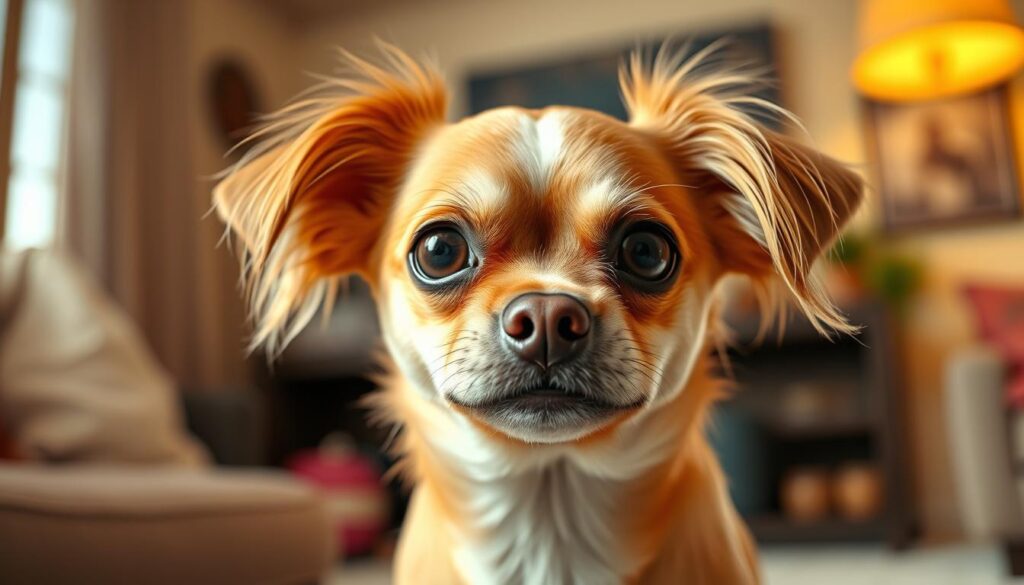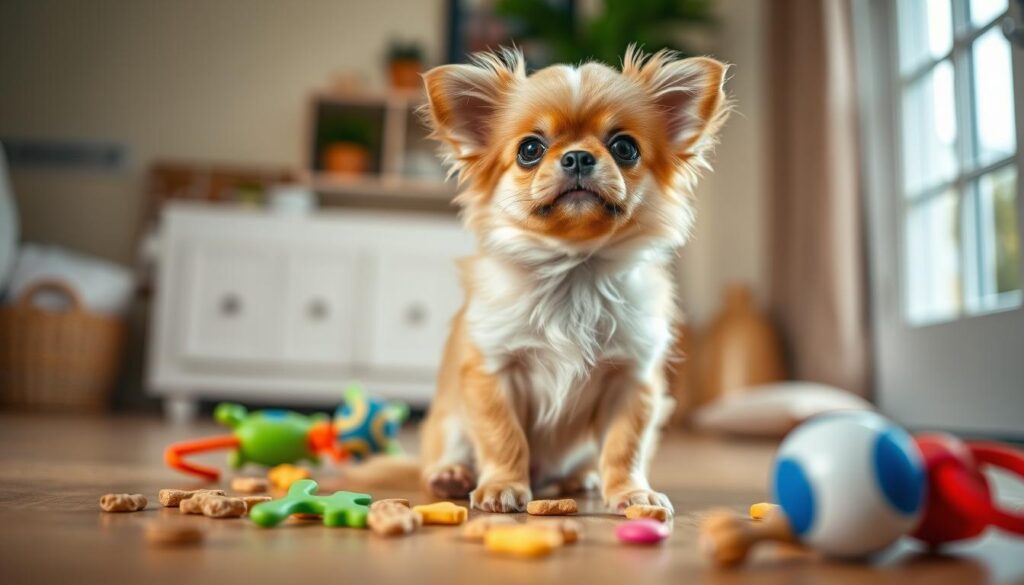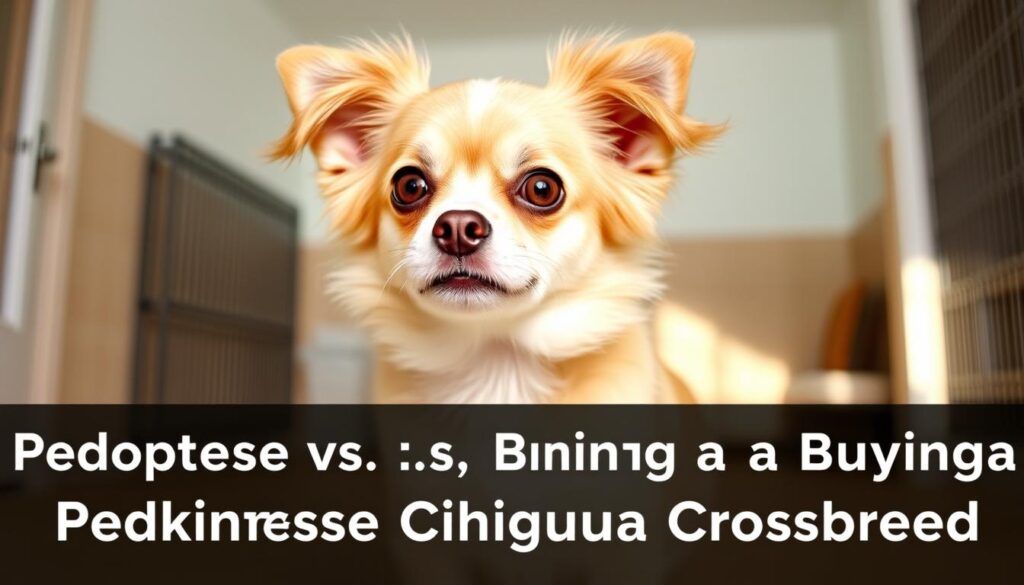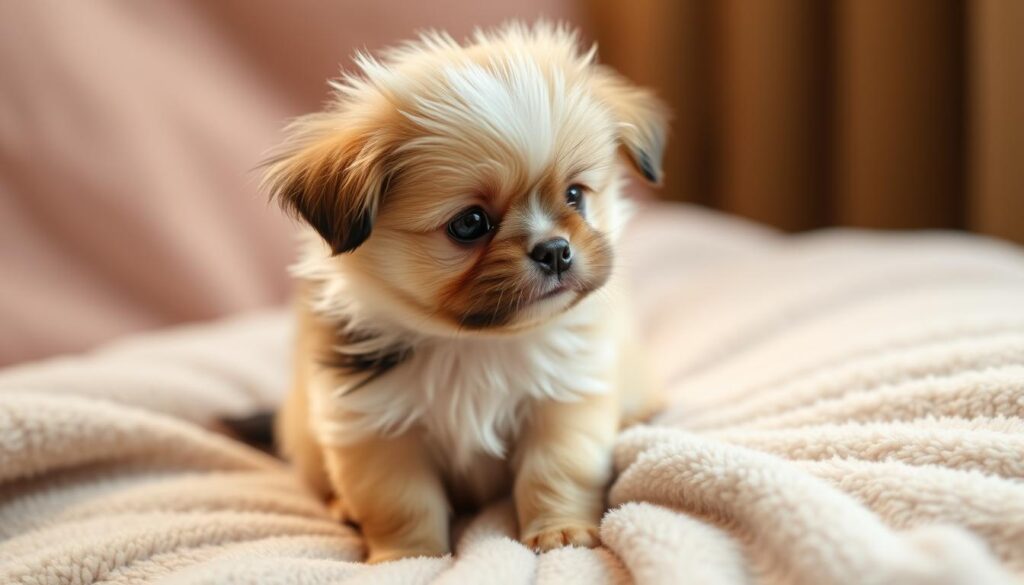Ever thought about a dog that’s both regal and sassy? The Pekingese Chihuahua mix, or “Cheeks,” is a designer dog that’s all the rage. It combines the Pekingese’s soft coat with the Chihuahua’s lively spirit. These dogs are small, weighing 7–12 pounds, and love living in apartments.
They’re also known as Pekachi or Chipeke. This mix has the Pekingese’s flat face and the Chihuahua’s bold nature. But what makes them special? Let’s explore their health, grooming, and watchdog skills. This guide is for anyone interested in the Pekingese Chihuahua mix, from their fun quirks to finding a good breeder.
Introduction to the Pekingese Chihuahua Mix
The Pekingese Chihuahua mix is a favorite among dog lovers. It’s also known as the Cheeks, Pekachi, or Chipeke. These dogs are small, under 14 inches tall, and perfect for city living.
Advertisement
They have the Pekingese’s royal look and the Chihuahua’s playful spirit. This mix is a hit in modern homes.
Origin of the Crossbreed
These dogs were first bred by accident. Now, some breeders do it on purpose. They mix the Pekingese’s flat face with the Chihuahua’s alertness.
Rising Popularity in the United States
In the U.S., these dogs are loved for their size and low-shed coats. They’re great for families and seniors because they fit well in small spaces. Social media has made them even more popular, showing off their looks and fun personalities.
Designer Dog Classification
Even though they’re not officially recognized, they’re called “designer dogs.” This means they’re bred for good traits like being hypoallergenic. But, they’re not officially recognized, and breeders use creative names to sell them.
What Makes the Pekingese Chihuahua Hybrid Special
The pekingese chihuahua hybrid, known as “Cheeks,” is a mix of two small breeds. They get the Chihuahua’s playful and loving nature. And they also inherit the Pekingese’s calm and noble spirit. This mix creates a dog that is both charming and easy to get along with.
- Temperament Blend: They have the Chihuahua’s alertness and the Pekingese’s calmness. This makes them great for many different homes.
- Distinctive Looks: They might have the Pekingese’s flat face or the Chihuahua’s smooth coat. But they all have big, expressive eyes and are small (7–16 lbs).
- Low Exercise Needs: They don’t need a lot of exercise. Short walks and playtime indoors are enough. This is great for people who live in apartments.
“Cheeks are like tiny clowns in fur suits—they’ll make you laugh daily!”
Health-wise, they might have some of the Pekingese’s health issues. But they often have fewer breathing problems. They can live for 12–16 years, which is as long as many small dogs.
Every pekingese chihuahua hybrid is different. Some might bark a lot like Chihuahuas. Others might like to sleep a lot. They are good for seniors, families, or anyone who wants a low-maintenance pet. With the right care, their characteristics of pekingese chihuahua mix make them perfect for today’s busy lives.
Physical Characteristics and Appearance
The pekingese chihuahua mix appearance can vary a lot. They mix the Pekingese’s big look with the Chihuahua’s small size. Knowing the characteristics of pekingese chihuahua mix helps guess what your dog will look like.
Size and Weight Expectations
Pekachis usually weigh 7–16 pounds and are 5–8 inches tall. Some might look more like Chihuahuas, while others will look like Pekingese. Their size depends a lot on their genes.
Coat Types and Colors
Coats can be very different, making them stand out. Here are some traits they might get:
| Coat Type | Parent Breed | Colors |
|---|---|---|
| Long, dense double coat | Pekingese | Fawn, black, cream, sable |
| Short, smooth coat | Chihuahua | Black, white, fawn, and tricolor |
Facial Features and Structure
Some Pekachis have the Pekingese’s flat face and big, dark eyes. Others might have the Chihuahua’s pointed nose. They can also have one ear up and one down.
Body Proportions
These dogs usually have a compact body with short legs. They have a balanced head and a sturdy but light torso. This mix creates a small but harmonious body shape.
Temperament and Personality Traits
The pekingese chihuahua mix personality combines traits from both breeds. These small dogs often show a calm demeanor like the Pekingese and boldness like the Chihuahua. Owners say they are devoted and lively, shaped by their upbringing and genetics.
A Reddit user called their mix “100% crazy,” showing how different each one can be.
She’s 50% Chi, 50% Pekingese, but 100% crazy.

Affectionate Nature
Pekingeses and Chihuahuas are very affectionate. The pekingese chihuahua mix often wants to be close to people. They love to cuddle and may stick to one family member.
The American Kennel Club says Pekingese are very affectionate, with a rating of 5/5. This trait is often seen in their mixes.
Loyalty and Protectiveness
These dogs are very protective of their space. The Pekingese’s history as a palace guard and the Chihuahua’s territorial nature make them alert. They often bark at strangers, even though they are small.
Social Behavior with Family and Strangers
| With Family | With Strangers |
|---|---|
| Playful, loyal, enjoys lap time | May be reserved or bark at unfamiliar faces |
Early socialization helps them feel less anxious. Without it, they might get anxious or even aggressive when left alone.
Exercise Needs and Activity Level
When caring for pekingese chihuahua mix dogs, finding the right balance is essential. These small crossbreeds do well with short, fun sessions, not long hikes. Some mixes, like one owner’s dog who hikes 6 miles daily, show a lot of energy. But most enjoy 20-30 minute walks and indoor play.
Their mixed heritage brings variety. Pekingese traits might make them like to nap, while Chihuahua ancestry can lead to sudden bursts of energy.
He stops in front of strangers, drops the ball at their feet so they can play with him. He’s the weirdest, silliest, most energetic dog I’ve ever had.
- Small breed stats: 79% of dogs in this size range require under an hour daily
- Focus on mental stimulation: Hide treats, use puzzle toys to engage their curiosity
- Brachycephalic caution: Avoid extreme heat or exertion for flat-faced mixes
Experts say 2-3 outings a day are best, mixing leash walks with games. The AKC FIT DOG program suggests 30-minute sessions in the morning and evening. Watch how your pet reacts—older mixes might need easier activities like slow walks or supervised play in the backyard.
Swimming or stair climbing can be good alternatives to high-impact runs. Always adjust exercise to fit your pet’s personality. Whether they love to fetch or prefer lounging in the sun, tailor activities to their unique needs.
Training a Pekingese Mixed with Chihuahua

Training a pekingese mixed with chihuahua is a unique challenge. You need to balance the Chihuahua’s sharp focus with the Pekingese’s calm nature. They are smart but picky, often choosing comfort over following commands. This means you need special strategies for caring for pekingese chihuahua mix puppies.
“The desire to be cozy on the couch will always win out, but you can be sure she is always listening!”
Intelligence and Trainability
Chihuahuas learn commands fast, but Pekingese might not want to repeat tasks. Keep training sessions short and fun. Treats work well for these food-loving mixes. Encourage them to explore to build their confidence.
Common Training Challenges
- Stubbornness during routine commands training
- Short attention spans (5–10 minutes per session)
- Resistance to housebreaking due to small bladder size
Effective Training Techniques
Use treats like chicken bits to reinforce commands. Being consistent is important—say commands calmly without yelling. Early socialization helps reduce fear-based barking.
| Technique | Implementation |
|---|---|
| Positive Reinforcement | Use treats to reward calm . |
| Leash Training | Begin walks in quiet areas to avoid overstimulation. |
Training sessions should last 15 minutes a day. Being patient and praising them helps build trust. This turns training into a special bonding time.
Living Arrangements and Space Requirements
The pekingese chihuahua mix can live in many places because they are small and easy to adapt. They do great in apartments if they have what they need. It’s important to keep them in a safe, enclosed area because they can slip through small openings.
Think about these things to make them happy:
- Secure fencing: Use solid barriers to prevent escapes
- Temperature control: Avoid extreme heat or cold due to possible brachycephalic traits
- Joint-friendly surfaces: Use padded bedding to support their small-frame anatomy
- Quiet environments: Aim for sound levels below 85 decibels to prevent stress
They like going outside, but they’re okay with just short walks or playtime inside. Make sure their indoor space has different textures like rugs and tiles. This helps them act naturally. The USDA says homes should be big enough for them to turn around easily.
Adding raised platforms and cozy spots makes them feel safe.
When I first found Grizzly on Craigslist, he was supposed to be a Shih Tzu/Pomeranian mix, but I guess they lied to get more money. Honestly, having him join our family was perfect. He started terrified in my room for five days, but now he’s the boss of this condo.
Things like puzzle toys and changing their bedding can help them relax. They fit well in city condos or suburban homes if they get enough attention from people. Their small size is great for renters, but they need places to go outside to stay healthy. Make sure their living space has both active and quiet areas to meet their needs.
Grooming Needs and Maintenance
Proper caring for pekingese chihuahua mix dogs is key. Their grooming needs come from both breeds. Here’s how to keep them healthy and shiny:
Coat Care and Brushing Frequency
Brushing depends on the coat type. Long-haired mixes need daily brushing with a slicker brush to avoid tangles. Short-haired types might only need weekly brushing. This routine helps manage shedding and keeps their coats smooth:
- Long coats: Daily brushing with a pin brush or comb
- Short coats: Weekly brushing with a soft bristle brush
- Trim mats immediately with blunt-tipped scissors
“Daily brushing is critical for long-haired Pekachis to avoid painful matting,” advise professional groomers.
Bathing Requirements
Bathe your pekingese chihuahua mix every 3-4 weeks with hypoallergenic dog shampoo. Avoid over-bathing to keep natural oils. Rinse well to prevent skin irritation.
Nail, Teeth, and Ear Care
Weekly care includes:
- Nails: Trim every 4-6 weeks to prevent cracking. Use small dog clippers.
- Teeth: Brush 3x weekly with dog-safe toothpaste. Pekinges are at higher risk of dental disease.
- Ears: Wipe weekly with vet-approved ear cleaner to prevent infections in their floppy ears.
Get a basic grooming kit with a pin brush, nail clippers, and pet-safe wipes. Regular care keeps your mix comfortable and healthy.
Nutrition and Diet Recommendations
Caring for Pekingese Chihuahua mixes means watching their diet closely. These small dogs need balanced meals to stay healthy and active. Their diet should focus on quality proteins and the right amount of food to keep them in top shape.
- Caloric Requirements:
- Puppies under six months: 0.4 cups daily, split into three meals.
- Adults (3-6kg): 0.75–1 cup/day, divided into two meals based on activity levels.
- Senior dogs may need reduced calories to avoid obesity risks.
Food sensitivities are common in these dogs. Choose high-protein kibble or raw diets like We Feed Raw’s beef formulas. These options provide important nutrients without harmful fillers. Adding ProDog products like Muscle+ or Bone Broth can help with joint and immune health. Avoid grains and use omega-3 fatty acids for a healthy coat and skin.
- Feeding Schedule:
- Adults: Two meals daily.
- Puppies: Three to four smaller meals to prevent hypoglycemia.
- Treats: Limit to 10% of daily calories to avoid weight gain.
Always talk to a vet before changing your dog’s diet. Sudden changes can upset their stomach. Slowly introduce new foods over 7–10 days for easier digestion. Regular vet visits help keep an eye on their weight and adjust their food portions as needed.
Common Health Concerns in Pekingese Chihuahua Mixes
Having a pekingese chihuahua mix is a joy, but it comes with health worries. Even though they might be healthier than purebreds, owners need to watch for problems from both sides.

- Brachycephalic Syndrome: Short noses from Pekingese can lead to breathing trouble, worse in heat or when active.
- Eye Disorders: Issues like corneal ulcers or dry eye might show up, with signs like squinting or red eyes.
- Joint Issues: Small size and long backs can lead to problems like luxating patella and IVDD.
- Heart and Dental Problems: Both breeds often face heart issues and severe tooth decay.
- Neurological Risks: Their small size raises the risk of spinal injuries and hydrocephalus in young ones.
Regular vet visits are key for catching problems early. Keeping their teeth clean, managing their weight, and avoiding too much heat helps a lot. Many pet insurance plans cover up to 90% of these pekingese chihuahua mix health concerns. Taking care of them early on means they can live a long, happy life.
Lifespan and Aging Considerations
The pekingese chihuahua mix health concerns greatly affect their lifespan. A well-cared-for Pekingese Chihuahua mix can live 10–18 years. Good nutrition, regular vet visits, and managing genetic traits can help them live longer.
Knowing the characteristics of pekingese chihuahua mix helps owners prepare for aging. As they get older, they might face joint stiffness, dental problems, or heart issues. Regular vet visits are key to catching problems early.
- Diet adjustments: Switch to senior formulas to support joint and heart health.
- Exercise moderation: Short, gentle walks instead of intense play to avoid strain.
- Comfort aids: Orthopedic beds and ramps for stairs ease mobility challenges.
Quality of life depends on managing pain and keeping them mentally active. Toys and gentle massage can help. Monitoring their weight is also important to avoid joint stress. By focusing on preventive care, these mixed breeds can enjoy their senior years fully.
Adopting vs. Buying a Pekingese Chihuahua Crossbreed
Choosing between adopting or buying a pekingese chihuahua mix involves ethics and practicality. Rescue groups help save lives and steer clear of puppy mills. Most pet owners, over 70%, choose adoption to avoid unethical breeding.

Find Ethical Sources
Good breeders focus on health, not profit. Look for breeders who:
- Provide veterinary health certificates and vaccination records
- Offer puppies aged 8–12 weeks for better socialization
- Show proof of genetic health screenings for parent dogs
Adoption Benefits
Adopting a pekingese chihuahua crossbreed costs $100–$300, much less than buying from a breeder ($500–$1,500). Shelters have many mixed breeds, including this hybrid. Over 30% of these mixes find homes through adoption, helping reduce overcrowding.
Key Questions to Ask
Before making a decision, ask:
- What health guarantees are provided?
- Are vaccination records complete?
- What is the puppy’s socialization history?
Rescue dogs are often spayed/neutered and vaccinated, saving money. Mixed breeds like the pekingese chihuahua mix have a 25% lower risk of genetic disorders than purebreds. Choose transparency and compassion for a healthy, happy family member.
Cost of Ownership
Before getting a pekingese chihuahua mix, it’s important to plan your budget. The initial costs can vary a lot. Adoption fees from shelters usually cost between $150–$450. On the other hand, some unethical breeders might charge $500–$1,500.
Experts say it’s best to choose ethical options. This supports the health and well-being of your pekingese chihuahua mix.
“The AKC reports that small breeds like this mix require at least $1,800 annually for essential care.”
- Monthly expenses:
- Food: $20–$35 (high-quality diets recommended)
- Veterinary care: $25–$40 (routine checkups)
- Grooming: $15–$30 (trimming and coat maintenance)
- Insurance: $15–$30/month
Annual costs can add up fast. You’ll also need to budget for flea prevention, training classes, and toys. These can cost $200–$400 each year. Over 10 years, the total cost can reach around $20,000.
Don’t forget to include spaying/neutering fees ($200–$500) and emergency care. It’s important to have money set aside for emergencies. About 40% of pet owners face unexpected vet bills over $1,000.
Smart planning is key to being financially ready. Focus on preventive care to save money in the long run. Make sure to budget for:
- Yearly vaccines
- Regular dental care
- Emergency savings fund
Being responsible with your pekingese chihuahua mix means more than just the initial costs. Consider hidden expenses like training and care for older pets. Look for local resources like low-cost spay/neuter programs and wellness plans.
Compatibility with Children and Other Pets
The pekingese chihuahua mix has a unique personality. It comes from blending traits of both breeds. This mix needs proper socialization to get along with families and other pets.
Interactions with Kids
Teach kids to handle these dogs gently. They are small and need watchful eyes during play. Many mixes love children but can get upset by sudden moves.
Introducing them to kids early helps them become good friends.
- Teach children to avoid roughhousing to prevent injury
- Positive reinforcement builds trust between mix and children
- Consistent supervision reduces stress for the dog
Getting Along with Other Dogs
Some mixes can be possessive. Socializing them with other dogs early is key. Training helps reduce territorial barking.
Behavior Around Cats and Other Animals
They might chase small animals. Introduce cats slowly in a neutral area. Reward them for staying calm near other pets.
“Consistent socialization from puppyhood helps them accept other animals,” say vets who know toy breeds.
Regular training boosts their confidence. They are naturally cautious but can learn to trust.
Is the Pekingese Chihuahua Mix Right for You?
Thinking about getting a pekingese chihuahua mix? First, learn about their characteristics. They mix the Pekingese’s calm with the Chihuahua’s alertness. Their small size (3–9 lbs) is perfect for apartments, but they need more than just space.
- Pros: They love to be with you, have low-shed coats (some), and live 10–14 years. They eat about 1 cup of food a day, which is good for small homes.
- Cons: They can get too attached and need firm training. They need weekly grooming and might have health issues like breathing problems.
They need patience and understanding. These dogs are very loyal but might be shy around new people. They’re great for families with older kids or seniors. Training them well helps with their barking.
Remember, they can be loud. If you live near neighbors or in a busy area, their barking might be a problem. It’s also important to watch their health because of their breed history. Look for pets that are microchipped and fully vaccinated from shelters or breeders.
Before getting one, ask yourself: Can you train them consistently? Do you have time for them every day? Their loyalty is worth the effort, but you must be ready for their needs. Research breeders, talk to vets, and plan for their special requirements before bringing one home.
Conclusion
The pekingese chihuahua mix, or Cheeks dog, is a mix of the Pekingese’s grace and the Chihuahua’s lively spirit. This mix makes a small, loving friend perfect for cozy homes. They might be a bit shy, but their playful and loyal nature makes them great pets for those who care for them deeply.
They need regular grooming because of their short fur. And because they are small, they must be handled gently to avoid harm.
Looking for a pekingese chihuahua mix? Start by finding a good source. Adopting from shelters in the U.S. can be a great way to find one. Early vet visits are key to keeping them healthy, as they can inherit health issues from both parents.
These dogs do well in cities but need training to stop barking too much. With the right care, they can bring joy for many years. Their curious nature and small size are perfect for families who love to stay active.
Each pekingese chihuahua mix is special, blending the Pekingese’s calm with the Chihuahua’s alertness. With love and care, they become beloved members of the family.
FAQ
What is a Pekingese Chihuahua mix?
The Pekingese Chihuahua mix, also known as a Pekachi, Cheeks, or Chipeke, is a small designer dog. It combines the charm of both the Pekingese and Chihuahua. These hybrids are loved for their cute looks and fun personalities, making them popular among dog lovers.
How did the Pekingese Chihuahua mix originate?
This crossbreed often comes from unplanned breeding. But, some breeders now create Pekingese Chihuahua hybrids on purpose. They are popular in American homes because of their small size and adaptability.
What are the typical traits of a Pekingese Chihuahua hybrid?
Pekingese Chihuahua mixes have traits from both parents. They might have the Pekingese’s royal history and independence. They also get the Chihuahua’s loyalty and alertness. Each mix can look and act differently, depending on the dominant traits.
What size can I expect my Pekingese Chihuahua mix to be?
A Pekingese Chihuahua mix usually weighs 7-16 pounds and is 5-8 inches tall. But, their size can vary based on their parents’ genes.
What types of coats do Pekingese Chihuahua mixes have?
Their coats can vary a lot. Some have long, thick fur like a Pekingese. Others have a shorter coat like a Chihuahua. They can be fawn, black, white, or cream.
Are Pekingese Chihuahua mixes good with kids?
Yes, they can be great with kids. But, their small size means they need gentle handling. Some may be more friendly, while others might be more cautious.
How should I train a Pekingese Chihuahua mix?
They are smart and can learn fast. But, they might be stubborn or have a short attention span. Use positive reinforcement, be consistent, and patient. Early socialization is key for a well-adjusted dog.
What kind of exercise does a Pekingese Chihuahua mix need?
They need regular, moderate exercise to stay healthy and happy. Short walks and playtime are good. This keeps them active and prevents obesity.
What are common health concerns for Pekingese Chihuahua mixes?
They might have dental issues from the Chihuahua side. They could also have breathing problems if they inherit the Pekingese’s traits. Regular vet visits are important to manage these risks.
What should I consider when adopting or buying a Pekingese Chihuahua mix?
Look for reputable breeders or consider adoption. Ask about health, temperament, and care needs. Choosing responsibly ensures a good match between dog and owner.
Source Links
- 10 Pekingese Mixes (With Pictures) – Dogster – https://www.dogster.com/dog-breeds/pekingese-mixes
- Pekingese Mix Breeds – Pekingese Central – https://pekingesecentral.com/pekingese-mix-breeds/
- Chihuahua Pekingese Mix – Your Ultimate Breed Information Guide – Your Dog Advisor – https://yourdogadvisor.com/chihuahua-pekingese-mix/
- Pekingese Hybrids – Pekingese Central – https://pekingesecentral.com/pekingese-hybrids/
- Meet The Pekachi, a Unique Mixed Breed Dog that Sounds Like a Pokemon! – Rocky Kanaka – https://rockykanaka.com/pekachi-a-unique-mixed-breed-dog-that-sounds-like-a-pokemon/
- Pekingese Chihuahua Mix: A Perfect Companion For Small Dog Lovers – https://www.thedailytail.com/pekingese-chihuahua-mix/
- Pekingese Breed: Characteristics, Care & Photos | Chewy – https://www.chewy.com/education/dog-breeds/pekingese
- Cheeks Dog Breed Health, Grooming, Feeding, Temperament and Puppies – PetGuide – https://www.petguide.com/breeds/dog/cheeks/
- Pekingese Dog Breed Information & Characteristics – https://dogtime.com/dog-breeds/pekingese
- What To Know About Pekingese – https://www.webmd.com/pets/dogs/what-to-know-pekingese
- Cheeks (Chihuahua & Pekingese Mix): Info, Pictures, Care & More – Dogster – https://www.dogster.com/dog-breeds/cheeks
- Variation in activity levels amongst dogs of different breeds: results of a large online survey of dog owners from the UK – https://pmc.ncbi.nlm.nih.gov/articles/PMC5465859/
- No title found – https://www.akc.org/expert-advice/health/how-much-exercise-does-dog-need/
- Cheeks Dog (Pekingese-Chihuahua Mix) Info, Temperament, Puppies, Pictures – https://www.101dogbreeds.com/cheeks-dog.asp
- No title found – https://www.akc.org/expert-advice/dog-breeding/designing-kennels-with-behavior-and-welfare-considerations-in-mind/
- 19 Best Dog Breeds for Apartment Living – https://www.adoptapet.com/blog/breeds/dog-breeds-for-apartments
- Pekingese – https://www.petmd.com/dog/breeds/pekingese
- How Often Do You Need To Groom a Pekingese? – https://iheartdogs.com/how-often-do-you-need-to-groom-a-pekingese/
- Pekingese – https://www.pdsa.org.uk/pet-help-and-advice/looking-after-your-pet/puppies-dogs/small-dogs/pekingese
- Pekingese Feeding Chart – Pekingese Central – https://pekingesecentral.com/pekingese-feeding-chart/
- Pekingese Feeding Guide – https://www.prodograw.com/raw-feeding-guide/pekingese-feeding-guide/
- Ideal Diet for Pekingese’s – The Ultimate Pekingese Feeding Guide – https://iheartdogs.com/ideal-diet-for-pekingeses-the-ultimate-pekingese-feeding-guide/
- Know the Signs: 5 Most Common Health Issues in Pekingese – https://iheartdogs.com/know-the-signs-5-most-common-health-issues-in-pekingese/
- Choosing Between a Chihuahua and a Pekingese Chihuahua Mix – https://puppyheaven.com/blog/choosing-between-a-chihuahua-and-a-pekingese-chihuahua-mix/
- Common Chihuahua Health Issues – Pet Insurance Review – https://www.petinsurancereview.com/blog/common-chihuahua-health-issues
- Pekingese Lifespan: How Long Do the Dogs Live? – https://dogtime.com/reference/143908-pekingese-lifespan-how-long-do-they-live-many-years
- How Long Do Chihuahuas Live? Here’s Everything You Should About the Chihuahua’s Lifespan – https://rockykanaka.com/how-long-do-chihuahuas-live-everything-you-should-know-about-the-chihuahuas-lifespan/
- Pekingese | Temperament, Lifespan & History | Pooch & Mutt – https://www.poochandmutt.co.uk/blogs/by-breed/pekingese?srsltid=AfmBOoqam3GQPIPfDN_lQAMpjNmsDrSZxfnEY9XM6oM-SKOnK7hPJiQG
- 23 Insightful Questions You Should Ask a Dog Breeder | PetPlace.com – https://www.petplace.com/article/dogs/pet-care/23-questions-you-should-ask-a-breeder
- These Adorably Small Dog Breeds Stay Tiny Forever – https://www.countryliving.com/life/kids-pets/g43679662/small-dog-breeds/
- No title found – https://www.akc.org/expert-advice/lifestyle/know-true-cost-owning-dog/
- Monthly Cost to Own a Chihuahua – https://iheartdogs.com/monthly-cost-to-own-a-chihuahua/
- Do Pekingese Get Along With Other Dogs? – Pekingese Central – https://pekingesecentral.com/do-pekingese-get-along-with-other-dogs/
- Are Pekingese Good with Kids? – https://iheartdogs.com/are-pekingese-good-with-kids/
- Pekingese-Chihuahua mix Jamie is a little love bug – https://www.ocregister.com/2020/04/04/pekingese-chihuahua-mix-jamie-is-a-little-love-bug/
- 49 Popular Chihuahua Mixes: Info, Pictures & Traits – Dogster – https://www.dogster.com/dog-breeds/chihuahua-mixes
- 35 Best Chihuahua Mix Breeds Brimming With Love And Devotion – https://worldanimalfoundation.org/dogs/chihuahua-mix-breeds/
Advertisement
